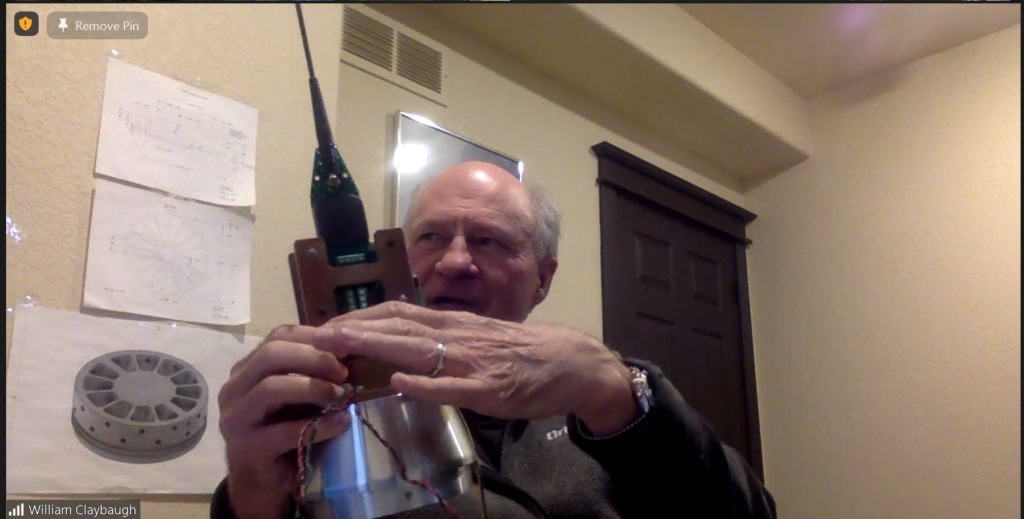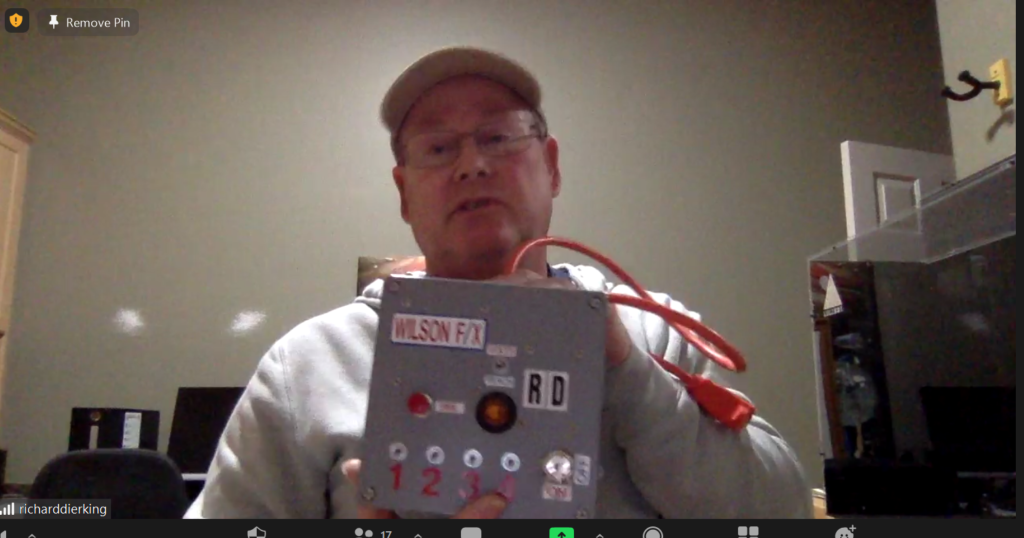by Keith Yoerg (RRS Secretary)
The latest meeting of the Reaction Research Society took place this past Friday, March 12th and had 20 attendees (who came & went at different times) – including a guest presenter. Society president Osvaldo began discussion by informing the group that USC has requested a launch of their 6″ booster rocket in April, before leaving the meeting to go on a Home Depot supply run.
GUEST PRESENTATION – GEORGIA TECH YELLOW JACKET SPACE PROGRAM
Sam Kim from the Georgia Tech Yellow Jacket Space Program made a presentation on their mission to be the first collegiate team to send a liquid rocket to Karman Line. The team conducted the first hot fire of an 800 pound-force LOX-kerosene engine in November 2019 (pictured below). This engine will support a sub-scale rocket which will be used to prove and test methods on this student-designed, -machined, and -assembled project.

The team has planned a launch for the sub-scale rocket in October to an apogee of 5,000 ft. An 11-second burn static fire of this engine is expected in April. The team conducts testing out of the DeKalb-Peachtree Airport, and plans to make launches from the Spaceport Camden in southeast Georgia.
BILL CLAYBAUGH’S 6″ ROCKET
Bill Claybaugh presented a number of hardware pieces related to a 6″ rocket which he hopes to launch this year. The rocket will fly on a 6″-diameter, 60″-long motor producing 1,350 lbf of thrust with an 8.3-second burn time. This design is optimized to be used as the second stage in a rocket boosted by a 9″-diameter motor, but the impending flight is only the 6″ second stage. Bill mentioned that he has a test flight planed for the 9″ first stage some time within the next year. The combined 2-stage rocket will have to fly out of a national range because of the expected altitude of 120 statute miles.
The hardware that Bill C. presented from his rocket included the tapered fins, bulkhead assemblies, and a section of the 40″ avionics payload which will be mostly contained within the nosecone. In addition, Bill provided insight on the FAA paperwork that he is currently completing for the flight of the 6″ rocket. The FAA form 7711-2 he has been working on is the same one used for airshows, and requires a supplemental that covers both class 2 & 3 amateur rockets. The final hurdle is the “splash pattern” Monte Carlo analysis of over 1,000 launches with varying launch angles, wind, and other launch parameters to determine the probability of landing in a populated area. He expects the launch will be deemed safe, and plans to submit the paperwork soon.
PLANS FOR THE UPCOMING MTA EVENT – SAT. MAR 20
Several members stated their intentions to join the launch & work event at the MTA site next Saturday, March 20th. Work on welding the new plate on the vertical test stand, clearing brush in the launch/firing areas, and other site maintenance may take place if time and equipment availability allow. There has also been discussion of taking an inventory of the working order of some Society equipment (such as the PA system) stored at the site.
Bill Inman plans to once again bring out his solar-powered steam rocket, Solar Cat, which uses mirrors to heat water with sunlight. Bill has been a fixture at MTA events the past several months, perfecting the design and procedures so that he won’t be caught unable to launch because of a minor oversight like untested equipment or cables that are too short. Although all of his equipment is flight-ready, MTA launches are always at the mercy of the Mojave desert weather. Wind, rain, and sunlight permitting – we hope to see the Solar Cat take to the skies next weekend!
Wolfram Blume is vaccinated (an impediment to his attendance at last month’s event) and ready for another launch attempt of the booster stage on his rocket, Gas Guzzler. In the final version the upper stage will include a gas-powered ramjet, but this flight will be flown with water instead. The goal of this test is to measure drag & acceleration, particularly during separation of the booster stage, which will help inform the final design parameters. We’re excited to see this launch, and expect it will be a fun one to watch!
Keith Yoerg will bring his model rockets and multi-pad wire rail launcher to test out deployment boxes and high-power solid rockets to test LoRa GPS trackers as a cheap rocket tracker. Dimitri is finishing work on a his hybrid & water rocket launch controllers (pictured above), both of which should be ready for testing on Saturday as well. It was once again agreed that a grill-out should take place, which is quickly becoming an MTA event tradition.
WIRELESS LAUNCH CONTROLLERS
The last topic stimulated a great discussion on the use of wireless launch controllers, with many members providing thoughts and opinions. Richard Dierking presented the commercially available Wilson F/X wireless control box, which consists of the firing box shown in the photo below and 2 wireless modules which run on 12V gel cell batteries. This entire system cost him around $900, and larger versions of this system have been used by the Rocketry Organization of California (ROC) and Friends of Amateur Rocketry (FAR) for launches of high-power solid rockets.
Dimitri expressed his comfort and trust in the Cobra wireless firing system, which he has used many times as the Pyro Op for million-dollar shots in movies and television. The Cobra system uses 64-bit encryption (it was suggested that the Wilson F/X system uses 32-bit) and the only issues Dimitri reported was when attempting to fire directly near an ultra high-speed camera. Richard stated that he would look into getting someone from the Wilson F/X company to attend a future RRS meeting to describe that system in further detail.
Most members expressed cautious optimism about the potential of using wireless launch controllers at RRS events, though it was re-iterated that the Pyro Op in charge has the final say in what firing systems may be used at any event. The consensus best path forward was progressing slowly by starting with LED lights & low energy firings like model rockets. The aim is to build experience with and knowledge of these systems to determine if they can be safely used for more energetic firings. Richard & Dimitri plan to bring the Cobra and Wilson F/X systems up to the MTA event next weekend, where (with the permission of the Pyro Op in charge) they will be tested safely on a small scale.
NEXT MONTHLY MEETING
The next RRS monthly meeting will be held virtually on Friday, April 9th at 7:30 pm pacific time. Current members will receive an invite via e-mail the week of the meeting. Non-members can request an invitation by sending an email to:
secretary@rrs.org
The Executive Council has committed to an additional monthly meeting moving forward to address administrative matters. Members who would like to discuss an admin topic in detail can request attendance at a Council meeting by sending an email to the Secretary at the address above.




